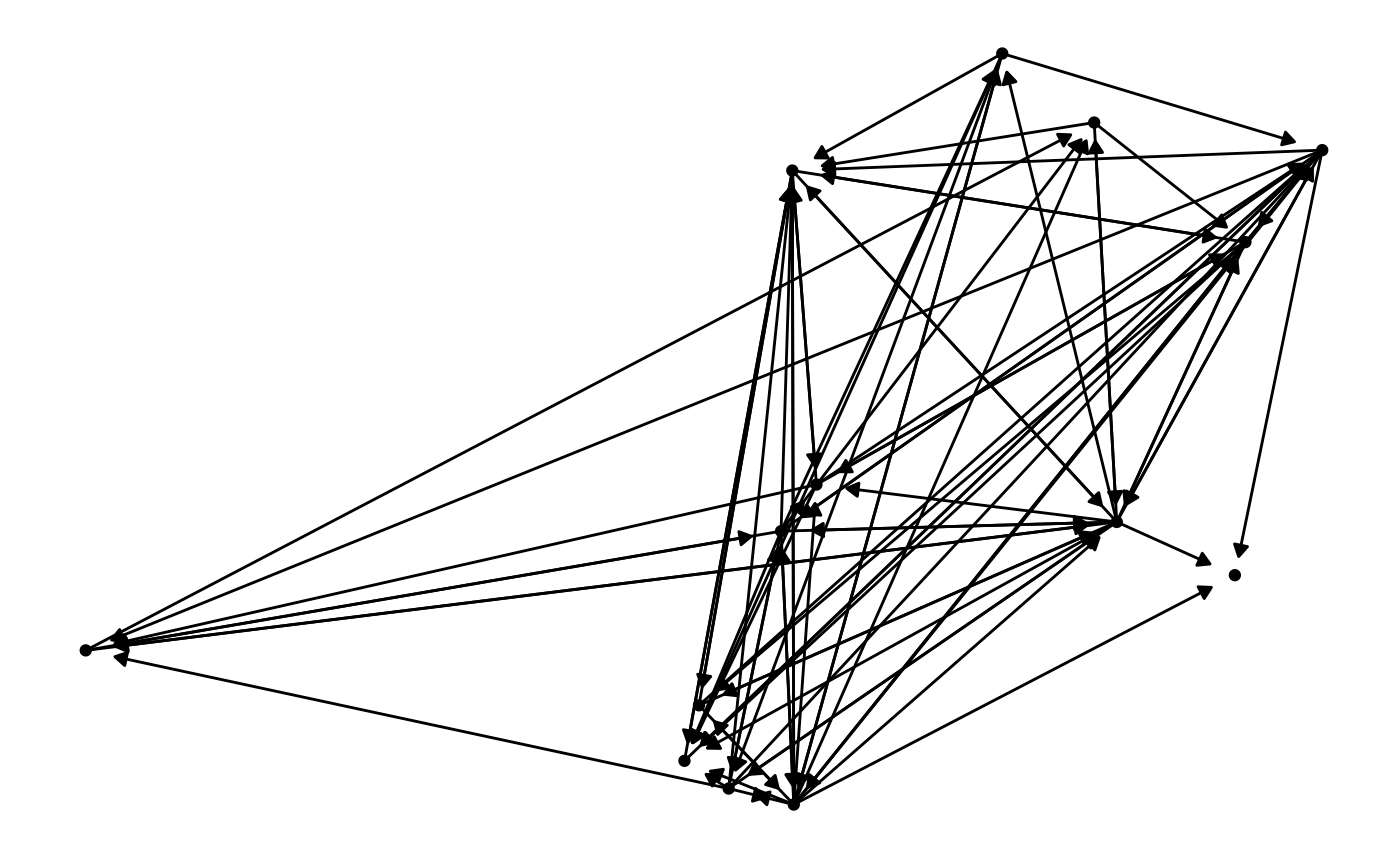See the vignette at https://briatte.github.io/ggnetwork/ for a
description of both this function and the rest of the ggnetwork
package.
# S3 method for class 'network'
fortify(
model,
data = NULL,
layout = "fruchtermanreingold",
weights = NULL,
arrow.gap = ifelse(network::is.directed(model), 0.025, 0),
by = NULL,
scale = TRUE,
stringsAsFactors = getOption("stringsAsFactors", FALSE),
...
)Arguments
- model
an object of class
network.- data
not used by this method.
- layout
a network layout supplied by
gplot.layout, such as"fruchtermanreingold"(the default), or a two-column matrix with as many rows as there are nodes in the network, in which case the matrix is used as nodes coordinates.- weights
the name of an edge attribute to use as edge weights when computing the network layout, if the layout supports such weights (see 'Details'). Defaults to
NULL(no edge weights).- arrow.gap
a parameter that will shorten the network edges in order to avoid overplotting edge arrows and nodes; defaults to
0when the network is undirected (no edge shortening), or to0.025when the network is directed. Small values near0.025will generally achieve good results when the size of the nodes is reasonably small.- by
a character vector that matches an edge attribute, which will be used to generate a data frame that can be plotted with
facet_wraporfacet_grid. The nodes of the network will appear in all facets, at the same coordinates. Defaults toNULL(no faceting).- scale
whether to (re)scale the layout coordinates. Defaults to
TRUE, but should be set toFALSEiflayoutcontains meaningful spatial coordinates, such as latitude and longitude.- stringsAsFactors
whether vertex and edge attributes should be converted to factors if they are of class
character. Defaults to the value ofgetOption("stringsAsFactors"), which isFALSEby default: seedata.frame.- ...
additional parameters for the
layoutargument; seegplot.layoutfor available options.
Value
a data.frame object.
Details
fortify.network will return a warning if it finds duplicated
edges after converting the network to an edge list. Duplicated edges should
be eliminated in favour of single weighted edges before using a network
layout that supports edge weights, such as the Kamada-Kawai force-directed
placement algorithm.
Examples
if (require(ggplot2) && require(network)) {
# source: ?network::flo
data(flo)
# data example
ggnetwork(flo)
# plot example
ggplot(ggnetwork(flo), aes(x, y, xend = xend, yend = yend)) +
geom_edges(alpha = 0.5) +
geom_nodes(size = 12, color = "white") +
geom_nodetext(aes(label = vertex.names), fontface = "bold") +
theme_blank()
# source: ?network::emon
data(emon)
# data example
ggnetwork(emon[[1]], layout = "target", niter = 100)
# data example with edge weights
ggnetwork(emon[[1]], layout = "kamadakawai", weights = "Frequency")
# plot example with straight edges
ggplot(
ggnetwork(emon[[1]], layout = "kamadakawai", arrow.gap = 0.025),
aes(x, y, xend = xend, yend = yend)
) +
geom_edges(aes(color = Frequency),
arrow = arrow(length = unit(10, "pt"), type = "closed")
) +
geom_nodes(aes(size = Formalization)) +
scale_color_gradient(low = "grey50", high = "tomato") +
scale_size_area(breaks = 1:3) +
theme_blank()
# plot example with curved edges
ggplot(
ggnetwork(emon[[1]], layout = "kamadakawai", arrow.gap = 0.025),
aes(x, y, xend = xend, yend = yend)
) +
geom_edges(aes(color = Frequency),
curvature = 0.1,
arrow = arrow(length = unit(10, "pt"), type = "open")
) +
geom_nodes(aes(size = Formalization)) +
scale_color_gradient(low = "grey50", high = "tomato") +
scale_size_area(breaks = 1:3) +
theme_blank()
# facet by edge attribute
ggplot(
ggnetwork(emon[[1]], arrow.gap = 0.02, by = "Frequency"),
aes(x, y, xend = xend, yend = yend)
) +
geom_edges(arrow = arrow(length = unit(5, "pt"), type = "closed")) +
geom_nodes() +
theme_blank() +
facet_grid(. ~ Frequency, labeller = label_both)
# user-provided layout
ggplot(
ggnetwork(emon[[1]], layout = matrix(runif(28), ncol = 2)),
aes(x, y, xend = xend, yend = yend)
) +
geom_edges(arrow = arrow(length = unit(5, "pt"), type = "closed")) +
geom_nodes() +
theme_blank()
}
#> Loading required package: network
#>
#> ‘network’ 1.19.0 (2024-12-08), part of the Statnet Project
#> * ‘news(package="network")’ for changes since last version
#> * ‘citation("network")’ for citation information
#> * ‘https://statnet.org’ for help, support, and other information
